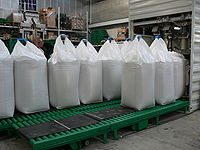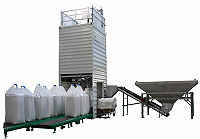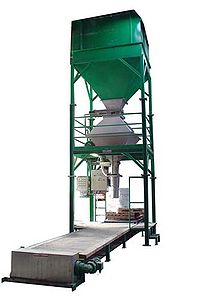Difference between revisions of "Big Bags"
| Line 36: | Line 36: | ||
==Construction== | ==Construction== | ||
U-Panel construction | U-Panel construction | ||
Circular/Tubular construction | Circular/Tubular construction | ||
Baffle construction | Baffle construction | ||
Four side panel construction | Four side panel construction | ||
Round construction | Round construction | ||
Revision as of 07:54, 2 March 2012
A Big Bag, Flexible Intermediate Bulk Container, FIBC , or Bulk Bag is a standardized container in large dimensions for storing and transporting dry, flowable products, for example sand, fertilizers , and granules of plastics.
Big Bags are most often made of thick woven polyethylene or polypropylene, either coated or uncoated, and normally measure around 110 cm or 45-48 inches in diameter and varies in height from 100 cm up to 200 cm or 35 to 80 inches. Its capacity is normally around 1000 kg or 2000 lbs, but the larger units can store even more. The average bulk bag made to ship one metric ton can weigh between 5-7 lbs.
Transporting and loading is done on either pallets or by lifting it from the loops. Bags are made with either one, two or four lifting loops. The single loop bag is suitable for one man operation as there is no need for a second man to put the loops on the loader hook. Emptying is made easy by a special opening in the bottom such as a discharge spout, of which there are several options, or by simply cutting it open.
Size
Bulk Bags come in many different sizes, they can be customized into just about any 3 dimension size possible. There are limits to the sizes of course, but usually you'll see standard bulk bags with a standard base dimension of 35" x 35". The heights of a bulk bag can range up to 96 plus inches tall. Again, the size and dimensions of bulk bags are determined by safety, functionality and usability by the customer.
History
Although there is disagreement on exactly where FIBCs were first made and used, it is certain that they have been employed for a variety of packaging purposes since the 1940s. These forerunners of the FIBC as we know it today were manufactured from PVC rubber and generally utilised within the rubber industry for the transportation of carbon black to be used as a reinforcing agent in a variety of rubber products. One of the first known importers of the PVC containers into the United States is Robert Williamson, founder and CEO of B.A.G. Corp., in 1969. These first PVC bags were imported from Japan as an efficient way to solve the loading and handling problem faced by crop dusters. By the 1960s, with the development of polypropylene combined with advances in weaving, the bulk bags as we know them today came into being and were rapidly adopted by a wide variety of oil and chemical companies to store and transport powdered and granular products. It was during the oil crisis of the mid 1970s that the FIBC really came into its own for transporting huge quantities of cement to the Middle East from across Europe for the rapid expansion of the oil producing countries. At its zenith, upwards of 50,000 metric tons of cement was being shipped out on a weekly basis to feed the vast building programme. The Flexible Intermediate Bulk Container Association (FIBCA) was formed in 1983 by the companies that were manufacturing bulk bags at that time. The modern FIBC transports a growing figure of over ¼ billion tonnes of product each year and is used to handle, store and move products as varied as cereals to powdered chemicals and flour to animal feeds. With a capacity of up to 3m³ and load capability ranging from ½ a tonne to two tonnes FIBCs are highly cost effective, easily recyclable and ideal for virtually any free-flowing granule, powder, pellet or flake. FIBCs are also being developed to hold and filter fluid products.
Construction
U-Panel construction
Circular/Tubular construction
Baffle construction
Four side panel construction
Round construction
Lifting options
Cross corner lifting loops
Corner lifting loops
Four loops
Two loops
Sling loops
Full loops
Electrostatic properties
Type - A - no special electrostatic safety features
Type - B - Made from plain (non-antistatic) polypropylene. Type B bags are not capable of generating propagating brush discharges. The wall of this FIBC exhibits a breakdown voltage of 4 kilovolts or less.
Type - C - Conductive FIBC. Constructed from electrically conductive fabric, designed to control electrostatic charges by grounding. A standard fabric used contains conductive threads or tape.
Type - D - Anti-static FIBCs, essentially refers to those bags which have anti-static or static dissipative properties without the requirement of grounding.
Industries Served
Chemicals
Fertilizers
Fiberglass
Food Products
Grains
Mining (Used to hold shotcrete)
Pharmaceuticals
Pigments
Plastics
Refractories
Rubber Additives
SeedPeanuts
Starchwall coat powder
Flood Barrier Use
Thailand utilized big bags to erect temporary walls to protect areas during the 2011 Thailand floods. Walls built using big bags instead of smaller traditionally used sand bags were termed the big bag wall, or big bag barrier.
Video


